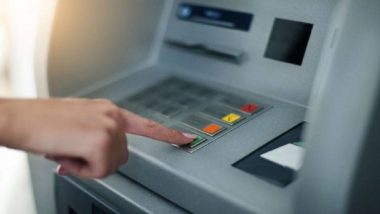New Delhi, October 15: An Automated Teller Machine, popularly known as the ATM, helps people to withdraw money in an incredibly quick, convenient and hassle-free manner. For people who use the ATM for the first time, it can be a little intimidating, but once an individual gets a hang of it, there's nothing like it for an access to quick cash. A person can access the ATM anytime, anywhere at your own convenience safely and effectively. Anyone with a credit card or debit card can access cash at most ATMs.
What is an ATM?
An automated teller machine (ATM) is an electronic banking machine that allows customers to complete basic transactions without the need of a branch representative or any person. The ATMs allows users to perform quick self-service transactions including deposits, cash withdrawals, bill payments, and transfers between accounts. The transaction fees are commonly charged for cash withdrawals by the bank where the account is located, by the operator of the ATM, or by both. Some or all of these fees can be avoided by using an ATM operated directly by the bank in which the customer his/her account.
Size of ATM card
The size of ATM cards is 85.60 mm × 53.98 mm (3.370 in × 2.125 in) and rounded corners with a radius of 2.88–3.48 mm, the same size as other payment cards, such as credit, debit and other cards. Due to the risk involved with ATM cards, the RBI had issued guidelines to the banks to replace all magnetic strip cards with EMV chip cards.
How to Withdraw Money From ATM
The first and most important thing for a customer when using an ATM is to be safe as the machine has direct access to your bank account.
- Once inside the ATM, insert your card in the card slot in the machine to begin the transaction.
- Type in your PIN. This is typically 4 digits but can be longer up to 6 digits
- Choose a type of transaction- like from which account you would like to withdraw the money- from Savings account or Current Account
- Enter the transaction amount correctly,
- Select your receipt preference, if you want the printed receipt or no
- Once this is done, your transaction is completed, take the cash.
- Remove your card from the machine when directed on the screen
Dos and Don’ts While Using ATMs:
- Individuals should make sure that they conduct any ATM transaction in complete privacy
- Memorize your PIN (personal identification number) and enter the details correctly at the ATM.
- Ensure that you collect your Debit card after completing your transaction at the ATM machine
- The individual should make sure that the machine displays welcome screen after the completion of your transaction.
- Keep your ATM card carefully immediately after you finish the transaction
- Users should register their mobile number with the bank so that you can be notified for all your transactions.
- Be cautious about the suspicious devices if any are attached to the ATM and be alert of strangers who try to engage you in conversation.
- In case if your ATM card is stolen or lost, inform your bank and block your card to avoid any unauthorized transactions.
- Customers should check their bank statements periodically and also the SMS alerts sent by the bank.
Don’ts
- Don't lend your Debit card to anyone. Customers should keep their PIN number secret and not disclose it to anyone.
- Do not write your PIN on the card or card wallet or do not store it on your mobile which can be easily visible to people.
- Don’t let any person enter while you are withdraw cash from the ATM.
- Don’t share your PIN with anybody, including bank employees.
- Don’t take stranger’s help to conduct transactions or don’t handover your card to unknown persons.
- Avoid using a PIN that could be easily guessed, like your birthday or telephone number.
An ATM card is a payment card or dedicated payment card issued by bank. The ATM cards are payment card size and style plastic cards with a magnetic stripe and/or a plastic smart card with a chip that contains a unique card number and some security information such as an expiration date or CVVC (CVV). It enables a customer to access their financial accounts via it’s and other’s automated teller machines (ATMs) and to make approved point of purchase retail transactions (i.e. gas stations, grocery, hardware, department stores, etc.)
(The above story first appeared on LatestLY on Oct 15, 2020 12:49 PM IST. For more news and updates on politics, world, sports, entertainment and lifestyle, log on to our website latestly.com).













 Quickly
Quickly


